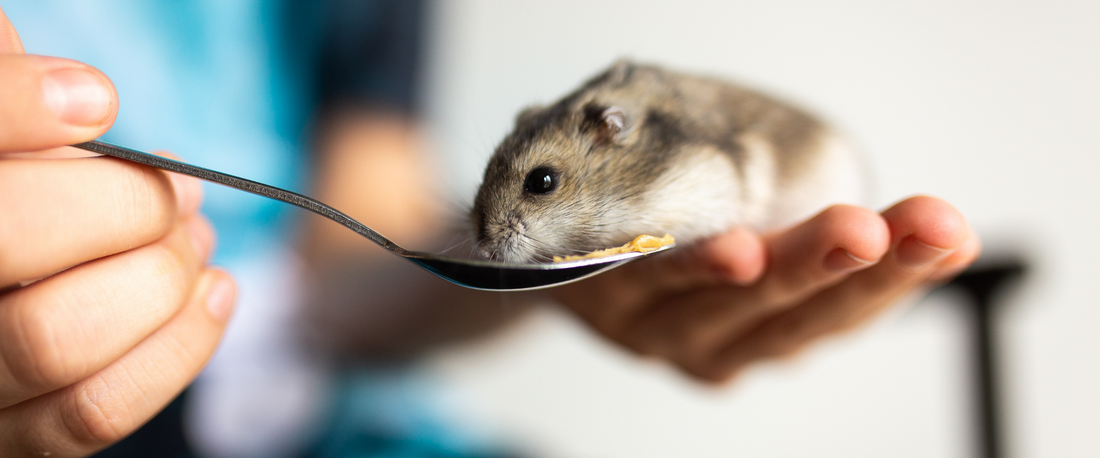
Hamsters are an incredibly popular pet choice in the UK, with an estimated 600,000 being kept as pets in the country, according to the RSPCA. With cute little faces and fun, quirky personalities, they make a perfect furry friend for many. However, don't let their small size fool you. Just because they are little doesn't mean they don't take much care. As with any pet - little or large - you need to carry out your research prior to ensure they are the right fit for you and that you know exactly what their needs are.
As well as what they eat and their daily routines, learning how to correctly handle hamsters is one of the most important things you'll need to know. To get you started, here's our handy guide on how to handle a hamster.

Who should handle a hamster?
While hamsters are a common pet for children, it's advised that they are only handled by adults and older children. They can be easily spooked and injured, so they're not always the best pet for small children to hold. Instead, let little kids feed them and pet them whilst in their enclosure.
If being able to pick up their pet is important to your child, you could perhaps look at getting a rabbit, ferret or a rat, as these are more social animals. For more information, check out our guide on finding the right small pet for you.
How to pick up a hamster
Hamsters are delicate little creatures, so if you don't pick them up correctly or are a bit rough with them it can lead to injuries. Learning how to approach and pick them up not only allows you to handle them safely but ensures that they're not so scared and will feel more comfortable in being regularly handled. This is why it's super important to carry out your research on how to handle a Syrian hamster for the first time (or any hamster or small pet breed for that matter).
Step 1: wash your hands
It's always best to pick up your hamster with clean hands. They have a great sense of smell, so if they can get a whiff of food they may be tempted to have a nibble.
Step 2: check their mood and if they're awake
Your little one will be most active during the night, so it's likely they'll be sleeping when you want to play. Although it's best to wait until the evening, you can attempt to wake them up, but just ensure you do it slowly. How would you like to be startled awake from your warm, cosy bed?
You can try gently shuffling the hay or quietly talking to them to see if they stir. If not, leave them be. If they do wake up, give them a couple of minutes to wake up or you'll end up with one very groggy hamster.
Step 3: softly scoop them up
If you think that your hamster is happy to be held, place bold hands on either side of your pet to form a cup before scooping up slowly in your palms. Mind that your hamster doesn't jump out, as they could hurt themselves. If it seems like they want to go back down, place them carefully back in their cage for now.

How to start handling a hamster
Despite their nervous nature, hamsters can be taught a routine. Over time, they will become used to being handled and grow to love it. Gradually building up handling time not only allows your fluffy friend to get accustomed, but it gives you the opportunity to grow in confidence too.
To start off with, handle them little and often, aiming for no more than 10 minutes at a time. Your hamster will start to realise that handling isn't so scary after all and that they'll always end up back in their home. Over time, you'll see them start to feel more settled in your hands, and that's when you can increase the length of time. For some, it may only be a couple of weeks, but for others, it may be longer, so be patient and always let your hamster decide when they are ready.
If your hamster is very nervous at being handled but you need to move them to clean their enclosure or let them out in their ball for some exercise, you can carefully scoop them up in a plastic cup. It's a safer way of moving them until they are more comfortable in your hands.
How to hold a hamster
Once your hamster is safely and securely in your hands, keep them cupped at the sides to prevent them from jumping or falling out. Be incredibly gentle with them. They are sensitive to touch, so use a very light touch with no prodding or poking.
Although we love to stroke our pets, be sure that you don't go towards their face with your fingers or hands. This can be quite daunting and scare your hamster, causing them to bite or jump. When stroking, be sure to avoid their whiskers and nose.
How to handle a hamster that bites
Just like humans and other animals, all hamsters will have their own unique personalities. Some will love to be held and played with, while others won't enjoy it. In the wild, hamsters are prey, so they can be a little jumpy and are a naturally nervous species. If they are feeling scared or threatened, they will bite or jump away to defend themselves. Due to this, it's important that you always take the lead of your furry friend and only handle them when they are happy for you to do so.

How to handle a dwarf hamster
There are various breeds of dwarf hamsters, many of which make up some of our most beloved pets. When picking up and handling a dwarf hamster, the same rules apply as they do with any other hamster. You just need to bear in mind that their smaller size can make them even more prone to injury from being dropped, handled roughly or jumping. An extra bit of care and patience is all you need.
For more of our expert tips and tricks on caring for hamsters and other small pets, check out our guide on how to hold your guinea pig and finding the right small pet for you.

